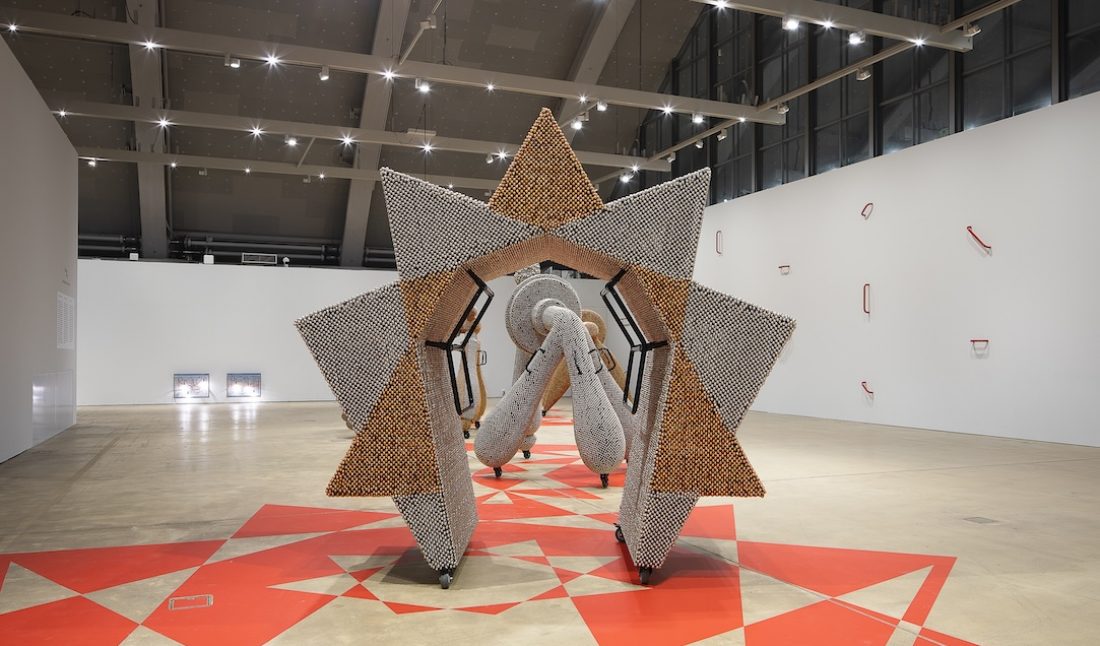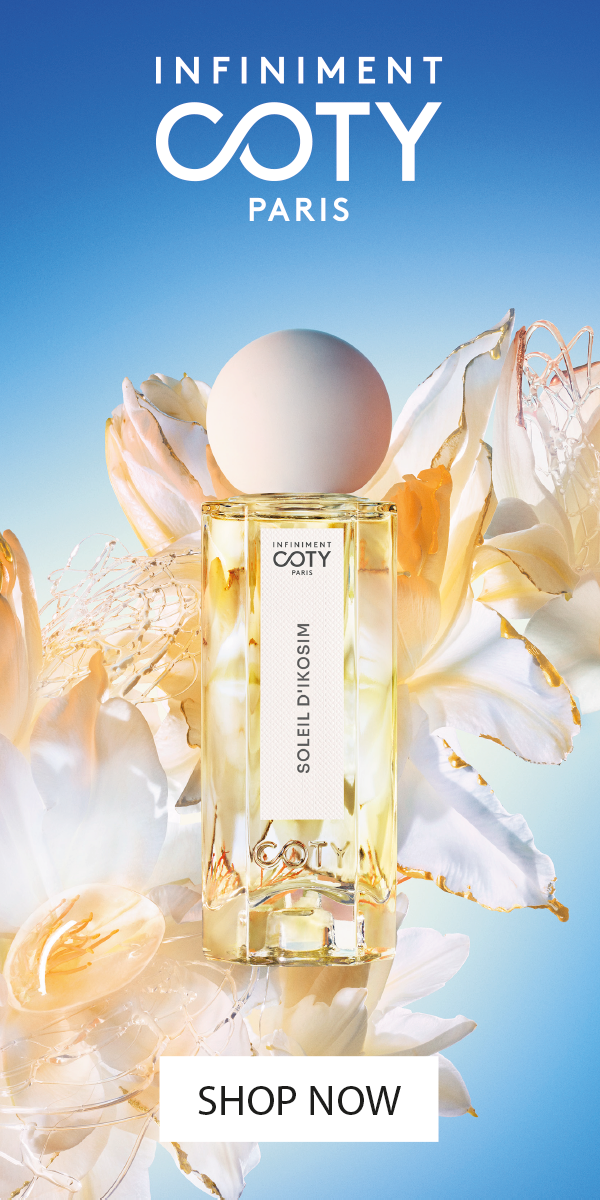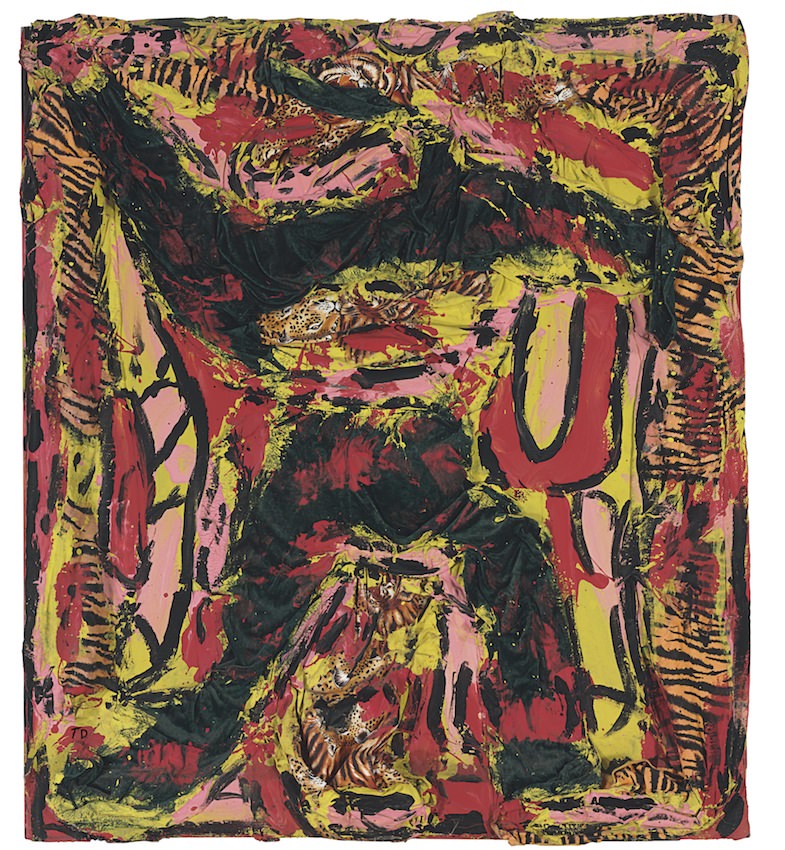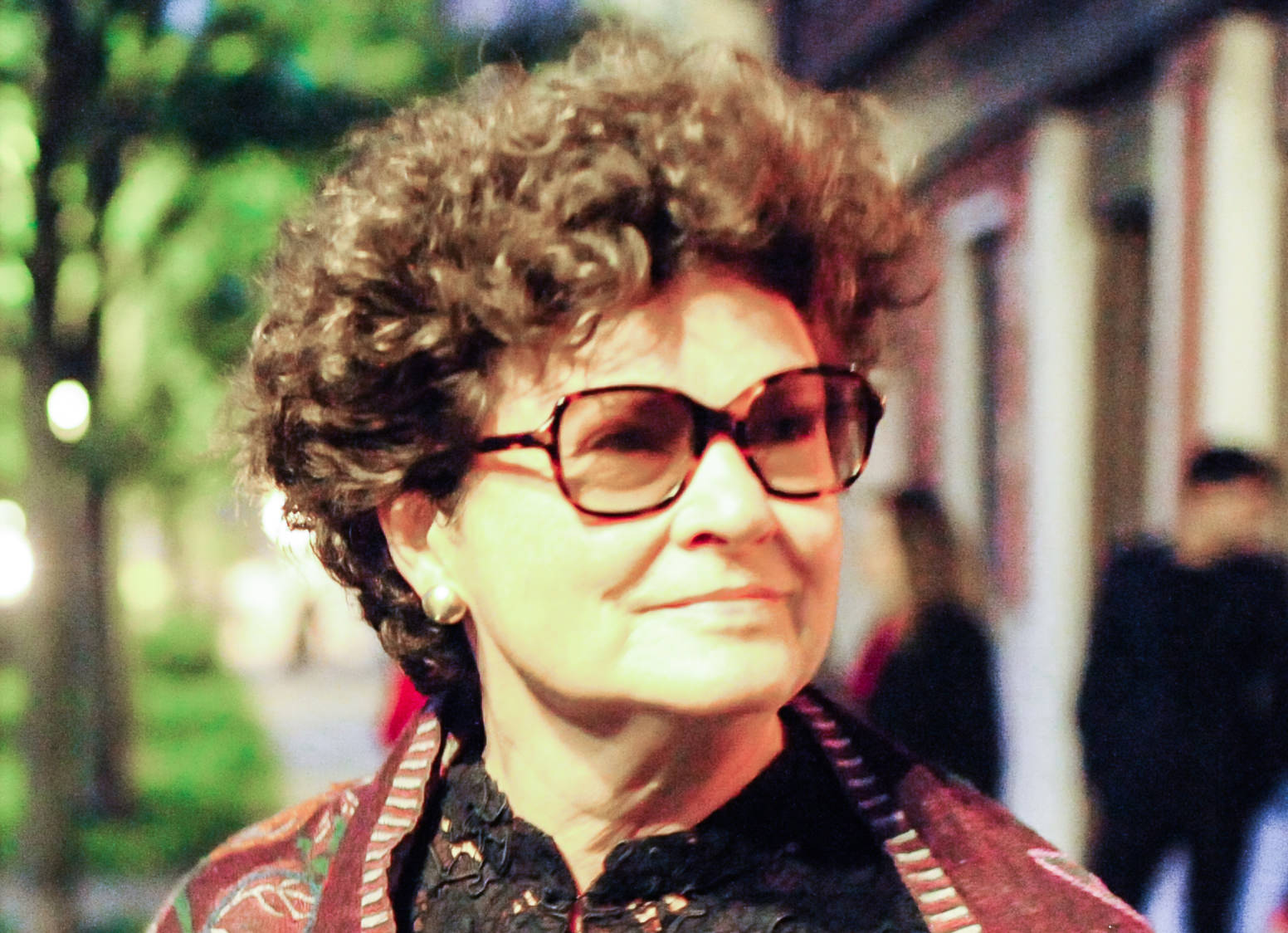Haegue Yang is often on the move. Such is the life of a successful international artist presenting multiple projects around the world throughout the year with a studio practice split between Berlin and Seoul.
In the span of one month last fall, she staged The Malady of Death in New York for the Performa Biennial 2023, debuted a new work for the Thailand Biennale, and saw the opening of the second stop of her touring solo exhibition “Continuous Reenactment” at the Helsinki Art Museum. And her 2024 is shaping up to have a similar breakneck pace, looking ahead to a survey show at Hayward Gallery in October. In speaking with Whitewall late last year, she described her tendency to travel as something to flow with, rather than fight.
Yang’s work is deeply researched. She has long been interested in indigenous communities and rituals, how people maintain connections to shamanism or paganism, even when they’ve fallen out of practice or acceptance by the ruling body. We see that connection to animistic rituals in her sculptures covered in metallic bells, her use of drums, her works in paper.
Yang’s installations elicit the desire to touch, to hear, to move, to transcend. They tap into multiple themes, just as they invite multiple perceptions. This makes sense, given that the artist described sensing multiple selves within her, not always in harmony.
The artist shared with us how she’s always in search of the unknown, and why she’s not afraid to tackle a difficult subject.
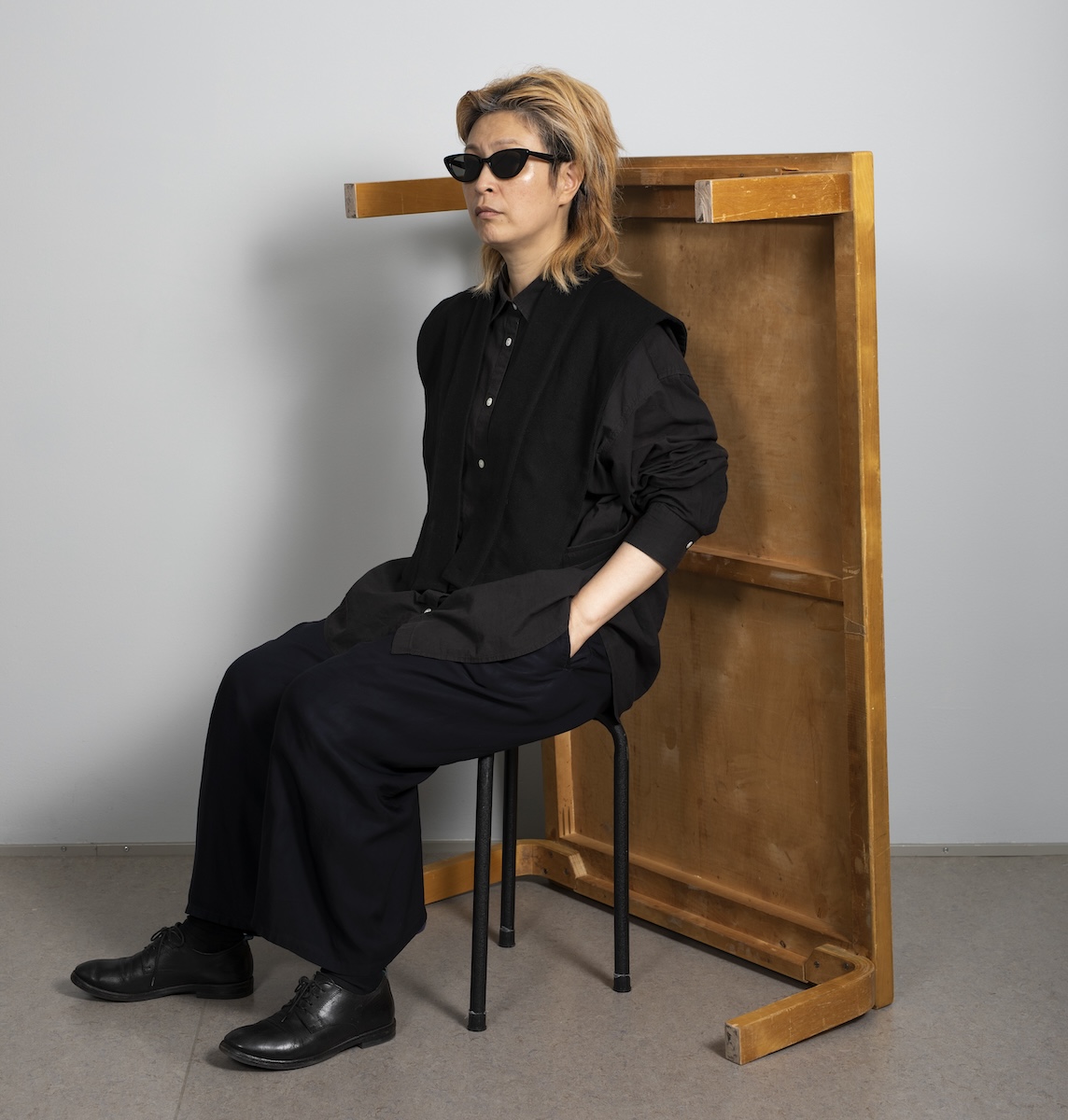 Haegue Yang, portrait of the artist, 2023, HAM Helsinki Art Museum, ©HAM/Sonja Hyytiäinen.
Haegue Yang, portrait of the artist, 2023, HAM Helsinki Art Museum, ©HAM/Sonja Hyytiäinen.
WHITEWALL: In December, your work Enveloped Domestic Soul Channels – Mesmerizing Mesh #208 (2023) debuted at the Thailand Biennale. It revolves around the paper home altars of the Hmong, an indigenous group in East and Southeast Asia. What was the starting point for this work?
HAEGUE YANG: An invitation to a biennial differentiates itself much from the one for an institutional show, especially this one, taking place in Chiang Rai, in northern Thailand. Bordering Myanmar and Laos, and also close to Yunnan, a province of China, Chiang Rai is a mountainous area, known as the Golden Triangle, lying at the confluence of the Ruak and Mekong rivers. In 1949 thousands of defeated Kuomintang soldiers came from Yunnan Province into the region where these three countries meet, and they seized control of the opium business. The remnant of Kuomintang soldiers became forebears of the private narcotic armies operating in the Golden Triangle, which continues today in Myanmar, the world’s second largest producer of illicit opium and a significant cog in the transnational drug trade since World War II.
It’s a typical peripheral area with weak governmental control, remote from the legitimate power, but culturally rich due to the diverse influences. I was especially interested in the rich hill tribal culture, such as Ahka, Karen, Lisu, Yao. In fact, over 20 different ethnic minorities have flourished in this area.
All the artists were invited for a site visit in Chiang Rai. The experience was so different from visiting art institutions and art galleries in major cities like New York, London, or Paris. The location was kind of a starting point, not only for me but also for many of the participants of the biennial.
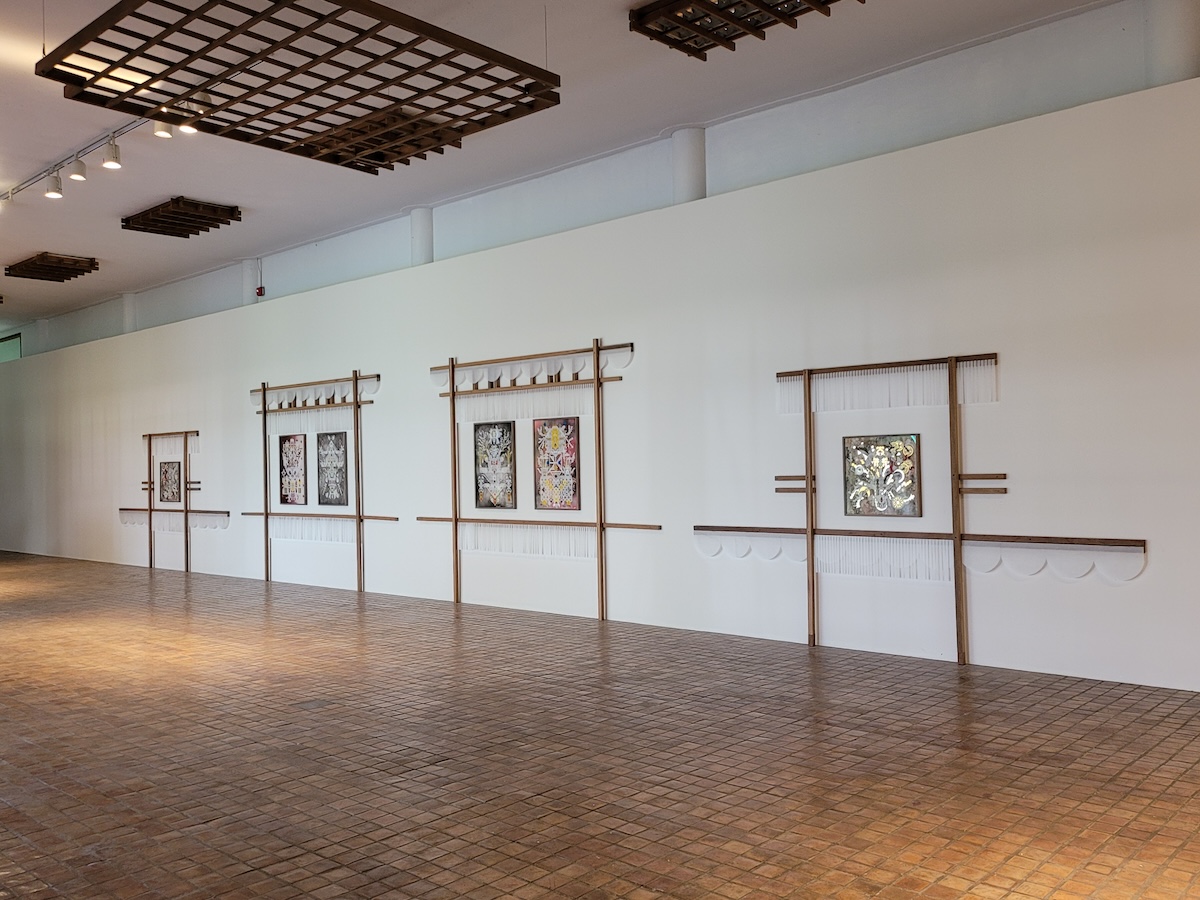 Haegue Yang, “Enveloped Domestic Soul Channels – Mesmerizing Mesh #208,” installation view at “The Open World,” Thailand Biennale, Chiang Rai, 2023 © Studio Haegue Yang.
Haegue Yang, “Enveloped Domestic Soul Channels – Mesmerizing Mesh #208,” installation view at “The Open World,” Thailand Biennale, Chiang Rai, 2023 © Studio Haegue Yang.
Exploring the Formal Features and Spiritual Orientations of Indigenous Rituals
WW: The work comes from your research in hanji and shamanistic paper folding and cutting that can be found across many cultures. How did that apply here?
HY: With this series of paper collages, titled “Mesmerizing Mesh” and made of folded or cut hanji, I was interested both in the formal features and spiritual orientations of indigenous animistic rituals. These vernacular animistic beliefs were seldom supported by any central governing power and were even frequently heavily suppressed by the major power. Yet, they have survived over a long period of time and remain as a part of the culture, such as shamanism or paganism. I’m so into the vitality or resilience of those so-called minor streams of orientation that have existed over time in civilizations.
I was unconsciously looking for something similar, and there were all these hill tribal cultures and the Lanna culture in general in the north of Thailand. And then “Mesmerizing Mesh” as a series already existed. Enveloped Domestic Soul Channels – Mesmerizing Mesh #208 was conceived when I found out that one of the hill tribes was using the same type of paper to cut their in-house shrine. And that was the Hmong tribe.
The central object for a lot of shamanistic traditions in many different geographic areas is actually a drum—a wooden frame and animal skin over it to make the sound that accompanies chants and ritualistic rites. Paper is actually proof of a highly civilized society, since paper making is such an advanced technique. Paper props in shamanism are therefore rather rare, making them an exceptional craft, even within the marginalized field of shamanism, which is my artistic interest in this collage series.
Inspired by Sacred Sites within the Home
WW: In terms of the installation, there is this structure that the collage sits within. Is that particular to the region as well?
HY: It’s inspired by the shamanistic altar that the Hmong people make at their home, which is decorated with papers carrying abstract motifs and patterns made by folding, cutting, and unfolding paper. And then there are some incense or offerings and some of the shamanistic props and tools. In Korea, nobody would have the altar at home throughout the seasons. Having this kind of constant altar at home and living with it was a practice I didn’t know of. It’s a sacred site; it looks like a house within a house. And by having an altar at home, each of their places becomes a sacred site.
I was looking into the Hmong tribe and learned about their immigration as refugees in the late seventies to the United States due to the Laotian Civil War. In the U.S., there is a huge population of Hmong people. I was interested in their diaspora and how they continue their traditions even in the U.S. despite their dispersion, since they can have an altar at home. It’s my speculative thought that maybe this portable altar enabled them to migrate so far without being completely uprooted.
WW: You have that sacred space wherever you are.
HY: Yes. So it’s about Thailand, about Chiang Rai, but also it’s about the Hmong and their migration. As an artist, my production evolves, as my research develops. I’m continuously traveling somewhere, and there is a kind of flow to follow up with. I sometimes have a feeling I’m only following this mysterious flow as if I’m a piece of drifting wood in the river.
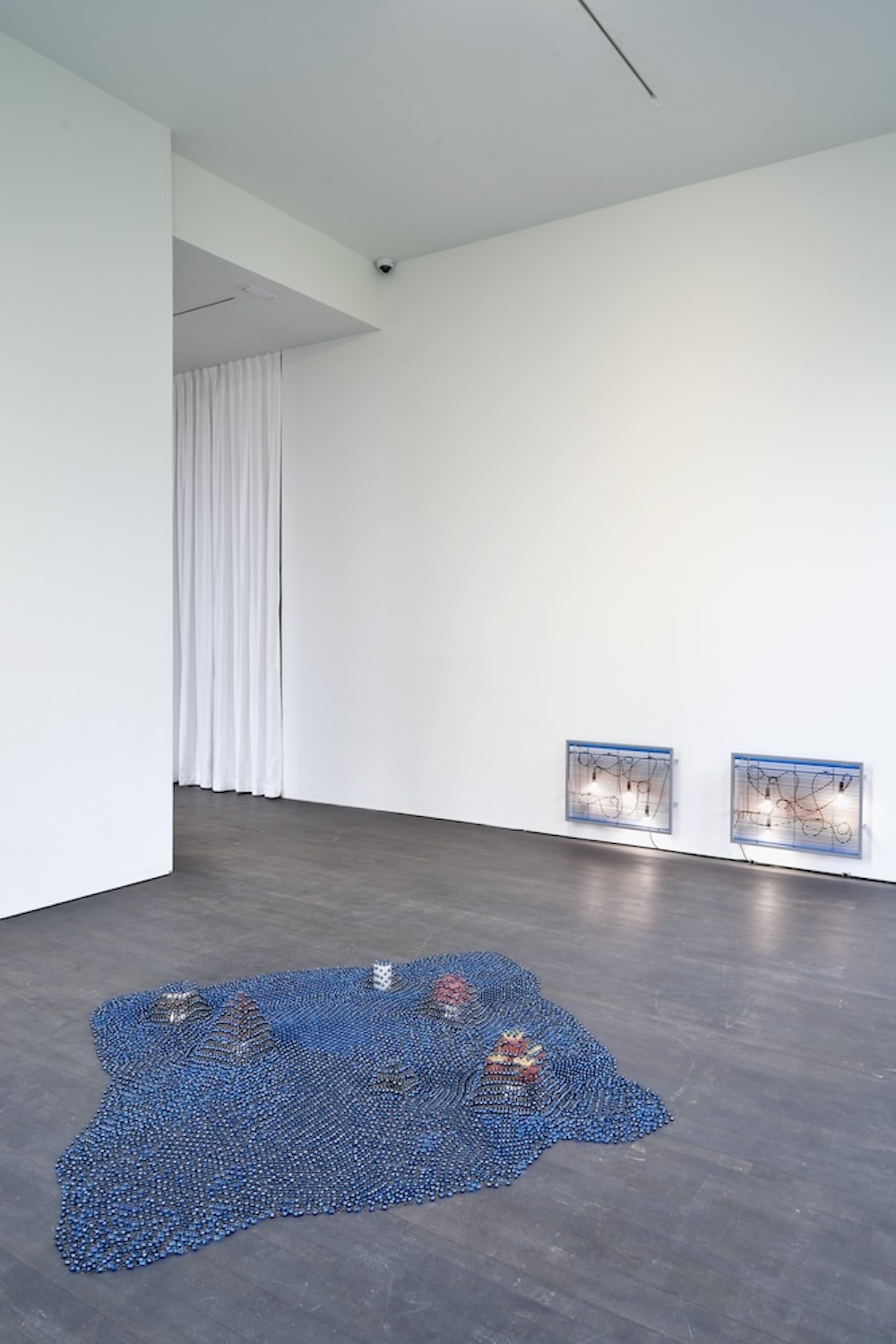 Installation view, “Haegue Yang: Several Reenactments,” S.M.A.K., Ghent, 2023 © Dirk Pauwels.
Installation view, “Haegue Yang: Several Reenactments,” S.M.A.K., Ghent, 2023 © Dirk Pauwels.
International Traveling Shows Evolve and Connect
WW: Speaking of travel, in another part of the world you have a big show at the Helsinki Art Museum (HAM), “Continuous Reenactments.” For an exhibition like that, that includes a broad range of your work, and is your first solo show in Finland, what is the starting point there? Is it a site visit or a conversation with the curator?
HY: My working process at the exhibition at the Helsinki Art Museum (HAM) was somehow the opposite of the way I worked at the Thailand Biennale, meaning, less site-specific. First of all, “Continuous Reenactments” was conceived as a second staging of a traveling exhibition, previously at S.M.A.K. in Ghent, which was titled “Several Reenactments.” With the accumulative title I wanted to give an idea about the shows evolving while traveling and that they are connected with each other.
Many of the productions or selected works were identical, yet more works were added to the checklist since the space of HAM is so much larger. However, the central works are the same, and both exhibitions have a strong sense of self-referentiality.
“I sometimes have a feeling I’m only following this mysterious flow as if I’m a piece of drifting wood in the river,” — Haegue Yang
WW: Two major pieces are on view, Handles (2019) and Warrior Believer Lover – Version Sonic (2023). The latter is a re-enactment of a 2011 sculptural ensemble, which has evolved into a group of pieces. Can you tell us about how this piece evolved?
HY: Warrior Believer Lover was a sculptural ensemble of 33 individual pieces comprising electric cables and objects drafted over clothing racks, which were so-called “Light Sculptures.” That gigantic production was special, since it was an incredible explosion of being so expressive, which was entirely new to me at that time. I often sense multiple selves in me that are often contradicting, even opposing, meaning, multiple Haegue Yangs, and some of these selves do not always allow but rather stop oneself to go. I think Warrior Believer Lover only came out because I somehow succeeded in letting myself go and be mercilessly expressive. I was kind of missing that vitality and extra generosity to myself, and I wanted to celebrate it again.
But funnily enough, Warrior Believer Lover in “Sonic” version, meaning they are made with metallic bells instead of electric cables and clothing racks, became junior-sized in terms of their physicality, especially in their height. In the 2011 version, it was as if one was walking in a cornfield. The crops were so high that when you walked between the sculptures, you became one of them. Whereas here in this sculptural field at HAM, it’s as if you’re walking in a rice field. Your lower body is still embedded with the sculptures, but your upper body and sight are completely free. So it was a kind of re-enactment, but in a different materiality and also a different physical modality.
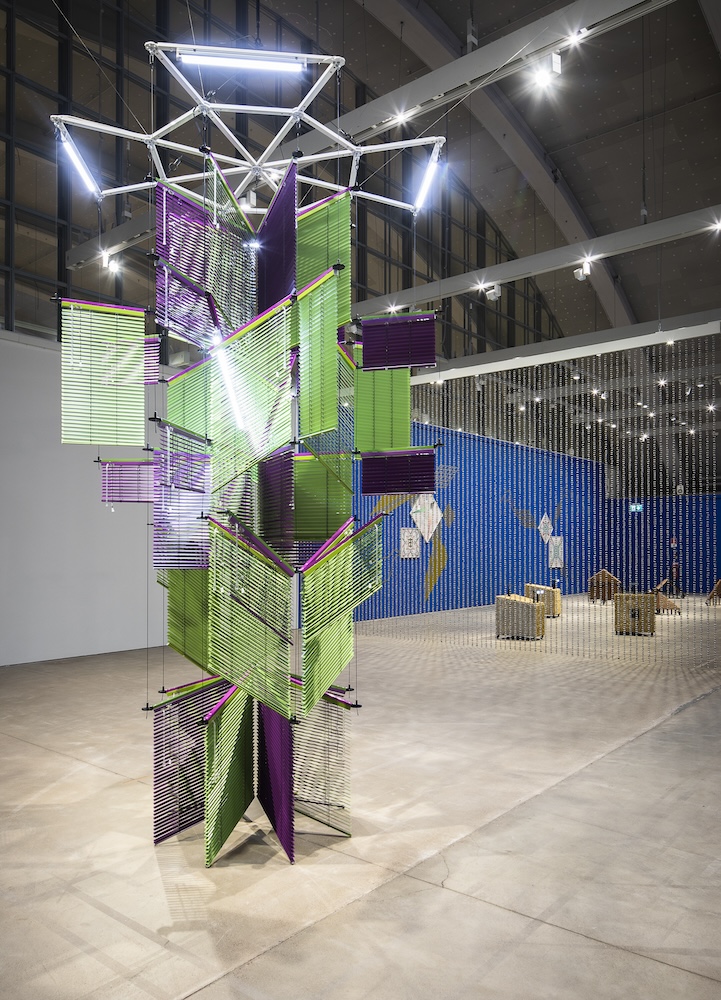 Installation view, “Haegue Yang: Continuous Reenactments,” HAM Helsinki Art Museum, 2023 © HAM/Kirsi Halkola.
Installation view, “Haegue Yang: Continuous Reenactments,” HAM Helsinki Art Museum, 2023 © HAM/Kirsi Halkola.
“I often sense multiple selves in me that are often contradicting, even opposing,” — Haegue Yang
WW: I wanted to ask about your “Sonic Guard” series, which covers the floor. Can you tell me about that?
HY: So far, I’ve produced two “Sonic Guard” pieces, and we have one here in a corner. As the title suggests, it guards something, while covering though not fully obscuring it. The intended scenario would be that of guarding over something. I think there are two aspects here that interest me. On one hand, it’s the sculptural aspect. I have attached bells for quite a while to a sturdy and hard frame. The bells are only on the surface—they provide the visual surface, but the form is given by the frame.
At some point, I realized that I wanted to use the bells in a purer way, so there were two different productions that came out; one was Sonic Rope, and the other Sonic Guard. And both are kind of soft sculptures. They don’t have a fixed hard shape and are rather flexible. Sonic Guard feels like a fabric, but of course is heavy, since it is metallic and is so cold. I was interested in the interaction between what is underneath and how the sonic fabric lies over it.
And I was interested in how to give a soul to that material. I can boil down my artistic interest to the matter and the soul and how these two elements interact with each other. In this case, Sonic Guard is guarding ordinary food containers—the most common metallic kettle, steel pot, tin lunch box, and rice bowls.
WW: Talking about object and soul, you use sound in so many ways in your work, and it can really connect the viewer with the soul. Music has this cellular stimulation. What do you like about working with sound, with music?
HY: Music and sound are two different things, and what I often use is sound rather than music. However, there are a few cases where I mobilized musical pieces alongside my installations. Music is composed, and there is an affiliated authorship that it could function as a reference, whereas sound functions more as an element to me. It’s more open, porous, and elemental. The sound of bells is an especially archaic sound, without any descriptive melodies, remaining basic and fundamental, with rhythmic beats that remind us of an archaic resonation—almost cosmic sounds. It’s that basicness I’m interested in.
Whereas the use of musical pieces creates a cultural reference. In the Helsinki show, I mobilized two musical pieces, Sacre du Printemps (1913) by Igor Stravinsky (1882–1971) and Images (1968) by Isang Yun (1917–1995). Listening to Images, we are reminded of Yun’s complex biography as a political dissident during the Cold War, since Images was composed during his imprisonment after being illegally abducted and falsely accused of being a North Korean spy.
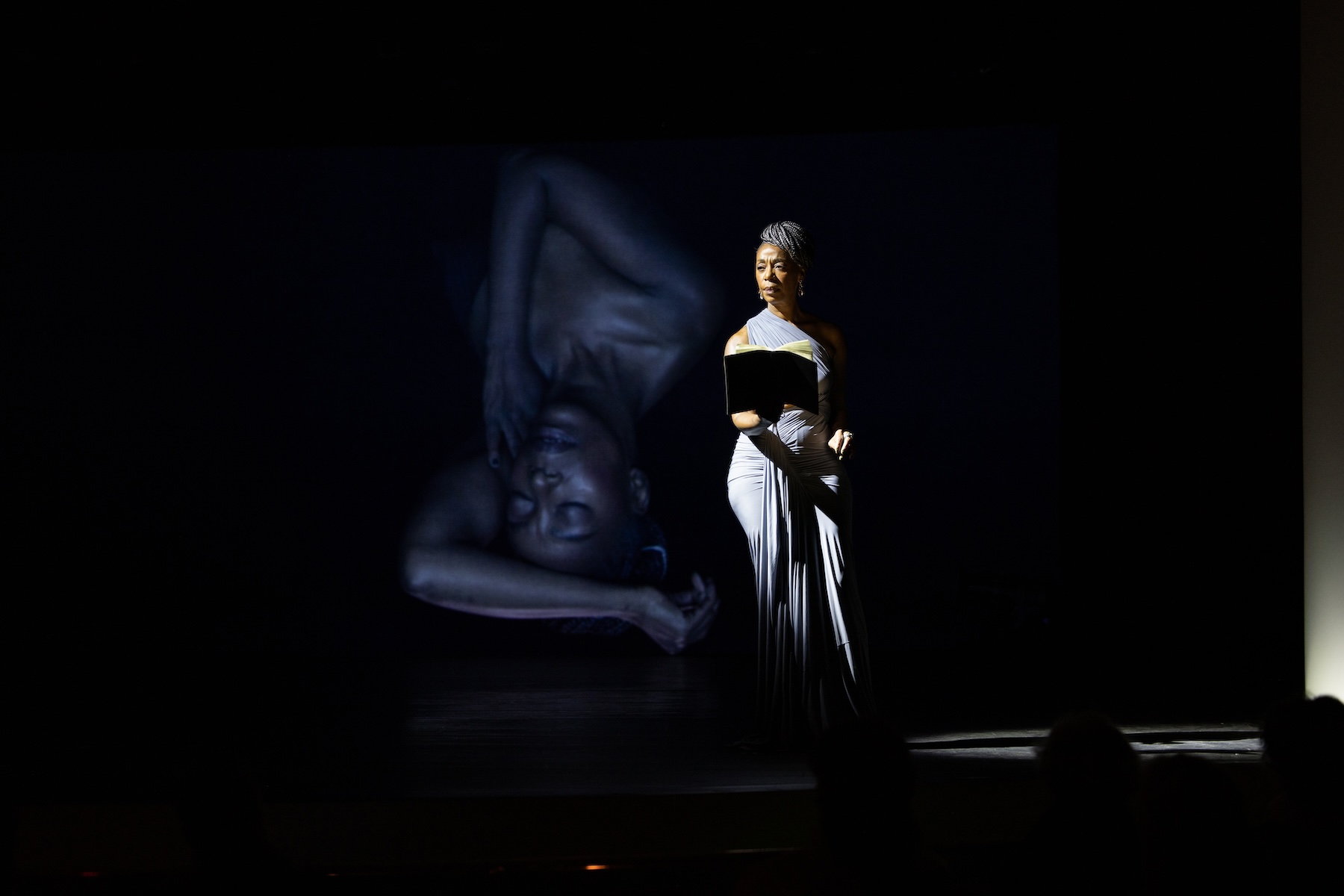 Haegue Yang, “The Malady of Death – Monodrama with Noma Dumezweni,” 2023, Performa Commission © Walter Wlodarczyk.
Haegue Yang, “The Malady of Death – Monodrama with Noma Dumezweni,” 2023, Performa Commission © Walter Wlodarczyk.
“I can boil down my artistic interest to the matter and the soul and how these two elements interact with each other,” — Haegue Yang
WW: You staged The Malady of Death at the Performa Biennial last November. It’s based on Marguerite Duras’s 1982 novella of the same name, and you’ve staged it several times in different places and spaces. How do you approach each new staging of this work?
HY: You’re asking about three very different types of works. I think it’s interesting to talk about all three, one right after the other. For biennials, I go to certain places; it’s kind of an adventure with new places. And then this institutional show comes from the accumulated progress of sculpture-making, and is a culturally minded excavation.
Based on literature, The Malady of Death is a staging project and a time-based piece. I’m mostly busy with exhibitions, so it is an extremely exceptional activity, an extracurricular activity as a sculptor. But there is one thing that has something in common with the Helsinki exhibition, which is the idea of revisiting, over and over again, this repetitive and recurring element, which also builds a conceptual aspect, whether I revisit Duras or my previous productions. And I see Duras as a conceptual artist, as I sometimes see myself.
As an artist I often observed how other artists and creative minds are being reduced, misunderstood, or illuminated only from one side, which feels so brutally unfair. The Malady of Death could be read as my personal endeavor to bring out the conceptual aspect of Duras’s writing in a less reductive way, but still by rendering them in contemporary, shareable forms. Each time I learn and discover so much, but at the same time I am so lost within it. Being lost in it seems to me evidence of not having lost any complexity of it.
And the notion of voice in that book as well as the voice as a medium on stage is so attractive. We were talking about sound and music, and now in The Malady of Death I’m talking about the voice as a medium. It’s a medium to read, a medium to listen to, a medium to see. The way Duras renders the notion of voice is so complex. Her sentences are clear but the meanings are complex. To the question of a journalist, “Why are your books so difficult?” Duras said, “Is your relationship with your mother simple?”
What’s wrong with being difficult? Why are you looking for simplicity? Why is that the right thing to do?
“As an artist I often observed how other artists and creative minds are being reduced, misunderstood, or illuminated only from one side, which feels so brutally unfair,” — Haegue Yang
WW: I know you have a calendar full of exhibitions for 2024, including a survey show at the Hayward Gallery in October. In the studio at the moment are there things that you’re thinking about, even themes or materials?
HY: I’m continually processing what comes my way, while I focus on both; one aspect is project-based works, the other one is the studio production, which is happening every day. But as an artist, one always and eventually has to look for something unknown. One looks for something without knowing what it is.







